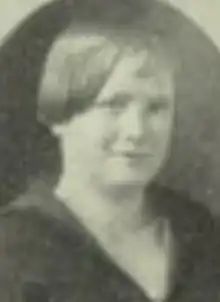Margaret S. Rood | |
|---|---|
 Margaret S. Rood, from the 1925 yearbook of Rochester High School | |
| Born | November 6, 1908 Marinette, Wisconsin |
| Died | September 11, 1984 Torrance, California |
| Occupation(s) | Occupational therapist, physical therapist, college professor |
Margaret Sigrid Rood (November 6, 1908[1] – September 11, 1984) was an American occupational and physical therapist. She developed techniques for treating central nervous system dysfunction, now known as Rood techniques or Rood's approach.
Early life and education
Rood was born in Marinette, Wisconsin, the daughter of Sophus Y. Rood and Maria Erickson Rood. Both of her parents were born in Norway. She graduated from Rochester High School, earned a bachelor's degree at Milwaukee-Downer College in 1932, and received a certificate in occupational therapy in 1933. Later in life, she earned a master's degree at Stanford University.[2]
Career
Rood worked as a therapist at a county hospital in Wauwatosa, Wisconsin from 1933 to 1936. She lived in Indianapolis from 1937 to 1943, when she was an occupational therapist in the Cerebral Palsy Clinic at James Whitcomb Riley Hospital, part of the Indiana University Medical Complex.[2][3]
From 1943 to 1952 and from 1959 to 1966, Rood was organizer and chair of the occupational therapy department at the University of Southern California (USC).[4] Under her leadership, USC began the first master's level program in occupational training in the United States.[5][6] "The need for trained therapists to assist the war wounded in mental and physical rehabilitation is critical," she told The Los Angeles Times in 1944.[7] From 1956 to 1957 she studied post-polio patients at Rancho Los Amigos Hospital. She retired in 1972.[2][8]
Rood developed a sequence of techniques for the treatment of children and adults with central nervous system dysfunction, now known as Rood techniques or Rood's approach.[9] She traveled nationally teaching these techniques.[10][11] In 1958, she received the Eleanor Clarke Slagle Lectureship from the American Occupational Therapy Association.[12] She was named the Sixth Mary McMillan Lecturer in 1969.[13] "Despite some controversy about the efficacy of Rood's techniques," notes a 2021 textbook in the field, "current neuroscience research continues to support the importance of sensory stimulation."[14]
Publications
Personal life and legacy
She died in 1984, in Torrance, California, at the age of 75.[2] There is a small collection of her papers in the University Archives at USC.[19] In 2017, Rood was recognised by the America Occupational Therapy Association as 1 of 100 people who influenced the 100 year history of occupational therapy.[8]
References
- ↑ Though some sources, including her gravestone, give 1909 as her birth year, the United States Social Security Death Index gives November 6, 1908 as her birthdate, and this earlier date matches the 1908 Wisconsin birth record for Margaret Sigrid Rood of Marinette, Wisconsin; via Ancestry
- 1 2 3 4 Cromwell, Florence S. "In Memoriam: Margaret S. Rood; 1909–1984" American Journal of Occupational Therapy 39(1)(January 1985): 54-55.
- ↑ "Regional P-T Congress is at Tell City; Large Local Delegation to Attend". Evansville Press. 1939-10-22. p. 34. Retrieved 2023-01-27 – via Newspapers.com.
- ↑ "USC Presented $14,000 Polio Research Fund". Los Angeles Evening Citizen News. 1952-07-24. p. 10. Retrieved 2023-01-27 – via Newspapers.com.
- ↑ Callan, Mary Ann (1949-03-18). "Southlander off to Parley on Occupational Therapy". The Los Angeles Times. p. 33. Retrieved 2023-01-27 – via Newspapers.com.
- ↑ "Trick Devices Help Disabled". Burlington Daily News. 1951-04-05. p. 13. Retrieved 2023-01-27 – via Newspapers.com.
- ↑ "New Therapy Course will Open at S.C." The Los Angeles Times. 1944-06-28. p. 18. Retrieved 2023-01-27 – via Newspapers.com.
- 1 2 "100 Influential People in Occupational Therapy: Margaret S. Rood, MS, OTR, PT". OT Centennial. Retrieved 2023-01-27.
- ↑ Midha, Divya (2019). "Rood's Approach". In Sharma, Krishna N (ed.). Advanced Techniques in Physiotherapy & Occupational Therapy. Jaypee Brothers Medical Publishers. pp. 119–130. ISBN 9789388958509.
- ↑ "Therapy Clinic Concludes Here". Argus-Leader. 1959-04-14. p. 5. Retrieved 2023-01-27 – via Newspapers.com.
- ↑ "UNC Medical Course Probes Nerve Disorders". The News and Observer. 1966-06-11. p. 15. Retrieved 2023-01-27 – via Newspapers.com.
- ↑ The Eleanor Clarke Slagle Lectureship Award, American Occupational Therapy Association.
- ↑ "Margaret S. Rood Sixth Mary McMillan Lecturer". Physical Therapy. 49 (6): 632–633. 1969-06-01. doi:10.1093/ptj/49.6.632. ISSN 0031-9023.
- ↑ Patnaude, Mary Elizabeth (2021-01-15). Early's Physical Dysfunction Practice Skills for the Occupational Therapy Assistant E-Book. Elsevier Health Sciences. p. 355. ISBN 978-0-323-55054-3.
- ↑ Rood, Margaret S. (April 1938). "Project for Treatment of Cerebral Palsy". American Journal of Physical Medicine & Rehabilitation. 17 (2): 93. ISSN 0894-9115.
- ↑ Rood, M. S. (February 1947). "A program for paraplegics". The American Journal of Occupational Therapy. 1 (1): 22–25. ISSN 0272-9490. PMID 20253096.
- ↑ Rood, Margaret S. (1952-02-01). "Occupational Therapy in the Treatment of the Cerebral Palsied". Physical Therapy. 32 (2): 76–82. doi:10.1093/ptj/32.2.76. ISSN 0031-9023. PMID 14911362.
- ↑ Rood, Margaret S. (1954-09-01). "Neurophysiological Reactions as a Basis for Physical Therapy*". Physical Therapy. 34 (9): 444–449. doi:10.1093/ptj/34.9.444. ISSN 0031-9023. PMID 13194374.
- ↑ "Rood (Margaret) papers". Online Archive of California. Retrieved 2023-01-27.